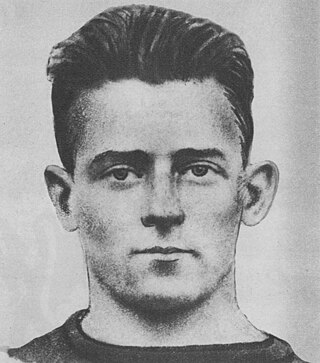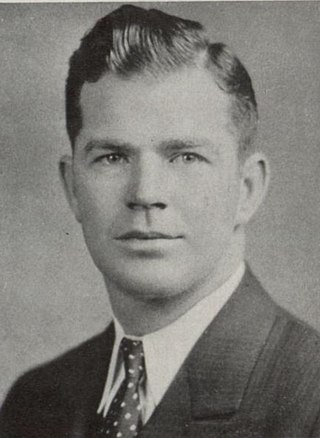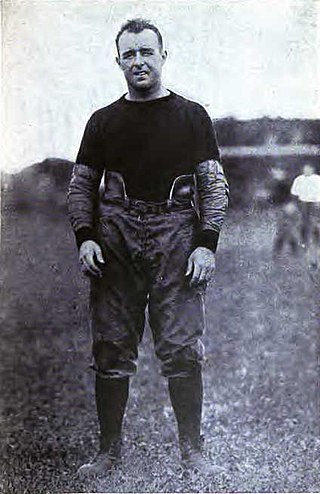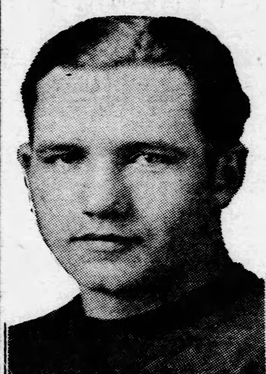Related Research Articles

Ernest Alonzo Nevers, nicknamed "Big Dog", was an American football and baseball player and football coach. Widely regarded as one of the best football players in the first half of the 20th century, he played as a fullback and was a triple-threat man known for his talents in running, passing, and kicking. He was inducted with the inaugural classes of inductees into both the College Football Hall of Fame in 1951 and the Pro Football Hall of Fame in 1963. He was also named in 1969 to the NFL 1920s All-Decade Team.

William Wallace Wade was an American football player and coach of football, basketball, and baseball, and college athletics administrator. He served as the head football coach at the University of Alabama from 1923 to 1930 and at Duke University from 1931 to 1941 and again from 1946 to 1950, compiling a career college football record of 171–49–10. His tenure at Duke was interrupted by military service during World War II. Wade's Alabama Crimson Tide football teams of 1925, 1926, and 1930 have been recognized as national champions, while his 1938 Duke team had an unscored upon regular season, giving up its only points in the final minute of the 1939 Rose Bowl. Wade won a total of ten Southern Conference football titles, four with Alabama and six with the Duke Blue Devils. He coached in five Rose Bowls including the 1942 game, which was relocated from Pasadena, California to Durham, North Carolina after the attack on Pearl Harbor.

August Michael Michalske, sometimes known as "Iron Mike", was an American football player and coach. He was inducted into the Pro Football Hall of Fame as part of its second induction class in 1964. He was also named in 1969 to the NFL 1920s All-Decade Team.

Bernard W. Bierman was an American college football coach best known for his years as head coach of the Minnesota Golden Gophers football program. Between 1934 and 1941, his Minnesota teams won five national championships and seven Big Ten championships and had four perfect seasons. Bierman's five national championships rank him among the greatest college football coaches of all time, as only 2 coaches have won more.

Wilbur Francis "Pete" Henry was an American football player, coach, and athletic administrator. He was a charter inductee into both the College Football Hall of Fame in 1951 and the Pro Football Hall of Fame in 1963.

Charles Emile "Gus" Dorais was an American football player, coach, and athletic administrator.

Ewing Young "Big 'un" Freeland was an American football and baseball player and coach of football, basketball, and baseball. He served as the head football coach at Daniel Baker College (1912–1914), Texas Christian University (1915), Austin College, Millsaps College (1921), Southern Methodist University, and Texas Tech University (1925–1928), compiling a career college football record of 77–49–16. Freeland was also the head basketball coach at TCU for one season in 1915–16 and at Millsaps for one season, in 1921–22. In addition, he was the head baseball coach at TCU (1916), SMU (1923–1924), and Texas Tech (1926–1927), amassing a career college baseball record of 50–47–3.

Mack Saxon was an American football and baseball player, coach of football, basketball, baseball, and track, and athletic administrator.

Allison Thomas Stanislaus "Pooley" Hubert was an American football player and coach of football and basketball. Regarded as one of the South's greatest college football stars, he played quarterback for coach Wallace Wade's football teams at the University of Alabama from 1922 to 1925, leading Alabama to its first bowl game, the 1926 Rose Bowl, known as "the game that changed the South." Wade called him "undoubtedly one of the greatest football players of all time." Hubert later became the head football and basketball coach at the Mississippi State Teachers College—now known as University of Southern Mississippi—and Virginia Military Institute. He was inducted into the College Football Hall of Fame as a player in 1964.
The 1922 Florida Gators football team represented the Florida Gators of the University of Florida during the 1922 Southern Conference football season. The season was law professor William G. Kline's third and last year as the head coach of the Florida Gators football team. Kline's 1922 Florida Gators finished 7–2 overall, and 2–0 in their first year as members of the new Southern Conference, placing fifth of twenty-one teams in the conference standings.
The 1923 Florida Gators football team represented the University of Florida during the 1923 Southern Conference football season. This was Major James Van Fleet's first of two seasons as the head coach of the Florida Gators football team. Van Fleet was a serving officer in the U.S. Army and a professor of military tactics in the university's Reserve Officer Training Corps (ROTC) program, and had been a standout fullback on the undefeated West Point Cadets team of 1914. Van Fleet's 1923 Florida Gators finished 6–1–2 overall, and 1–0–2 in the Southern Conference, placing third of twenty-one teams in the conference standings.

Charles Edward Brickley was an American football player and coach. He was a two-time All-American at Harvard and set the college football records for career and single season field goals. He then served as the head football coach at the Johns Hopkins University in 1915 and Boston College from 1916 to 1917 and coached the New York Brickley Giants of the American Professional Football Association—now the National Football League—in 1921. He also competed the triple jump at the 1912 Summer Olympics.

Joshua Wilder Tasker was an American football, basketball, and baseball coach. He served as the head football coach at Connecticut Agricultural College—now known as the University of Connecticut—from 1921 to 1922, the College of William & Mary from 1923 to 1927, and Rutgers University from 1931 to 1937, compiling a career college football record of 67–52–11. Wilder was also the head basketball coach at Connecticut from 1921 to 1923 and William & Mary from 1923 to 1928, tallying a career college basketball mark of 66–49. In addition he served as the head baseball coach at Connecticut (1922–1923), William & Mary (1924–1928), and Rutgers (1932–1937), amassing a career college baseball record of 88–108–4.

The 1923 Alabama Crimson Tide football team represented the University of Alabama in the 1923 Southern Conference football season. It was the Crimson Tide's 30th overall and 2nd season as a member of the Southern Conference (SoCon). The team was led by head coach Wallace Wade, in his first year, and played their home games at Denny Field in Tuscaloosa, at Rickwood Field in Birmingham and at the Cramton Bowl in Montgomery, Alabama. They finished the season with a record of seven wins, two losses and one tie.

The 1928 Pittsburgh Panthers football team was an American football team that represented the University of Pittsburgh as an independent during the 1928 college football season. In its fifth season under head coach Jock Sutherland, the team compiled a 6–2–1 record, shut out seven of its nine opponents, and outscored all opponents by a total of 177 to 15. The team played its eight home games at Pitt Stadium in Pittsburgh.
William Newton Collins was an American football and basketball coach and college athletics administrator. He served as the head football coach at Missouri Wesleyan College in Cameron, Missouri from 1923 to 1925 and William Jewell College in Liberty, Missouri from 1927 to 1932. Collins was also the head basketball coach at William Jewell from 1928 to 1933, tallying a mark of 50–35.
Hugh Davidson was a former American football coach and scout. He served as the head football coach at the University of Montana from 1964 to 1966, compiling a record of 8–20.
Alfred Scotchard "Shag" Sheard was an American football player and coach.

Arnold Henry "Itch" Oehlrich was an American football player. He played college football as a fullback for Nebraska from 1925 to 1927. He also played professional football in the National Football League (NFL), principally as a halfback, for the Frankford Yellow Jackets in 1928 and 1929.

The Kent State football program represented Kent State Normal College in American football during its first decade from 1920 to 1929. The team was known as the Silver Foxes from 1920 to 1926 and as the Golden Flashes from 1927 forward. The team operated as an independent and compiled a record of 10–41–7 for the decade.
References
- ↑ "Ray Kirchmeyer Renamed Coach". The Buffalo Evening Times. January 4, 1929. p. 14 – via Newspapers.com.
- ↑ "Final Game Closes Many Grid Careers". Columbia Daily Spectator. November 25, 1925. p. 1.("Another backfield star, Ray Kirchmeyer, also plays his final game tomorrow. The flashy fullback will wear the moleskins for the last time as a Columbian player.")
- ↑ "Football's All-Time Top-10 Upset Victories". Columbia Lions. September 4, 2020.
- ↑ "Karpe's Comment". Buffalo Evening News. February 3, 1933. p. 27 – via Newspapers.com.
- 1 2 "Ray Kirchmeyer Grid Coach at Wagner Univer". The Brooklyn Citizen. March 12, 1937. p. 7 – via Newspapers.com.
- ↑ "Kirchmeyer Will Coach at Wagner". The Buffalo Evening Times. September 7, 1928. p. 18 – via Newspapers.com.
- ↑ "2019 wagner College Seahawks Football Media Guide". Wagner College. 2019. pp. 75, 87.